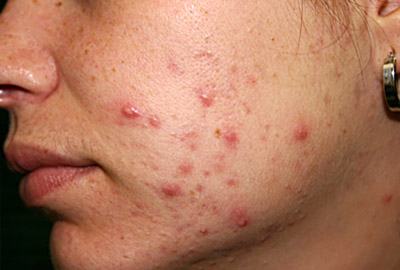ACNE 101

Acne (medically known as acne vulgaris) is a common skin disorder that affects approximately 85% of people at some point in their lives.
The main symptom is acne is the appearance of comedones, or pimples (colloquially known as “zits”), most often on facial skin. There are several different times of comedones:
Blackheads (open comedones): aAhair follicle blockage composed of excess keratin and sebum. This comedo may appear black due to exposure to the air.
Whiteheads (closed comedones): This type of comedo is essentially a blackhead whose contents are encased by the skin and not exposed to air.
Papules: Another type of closed comedo that is infected, inflamed, and often painful due to the buildup of bacteria and, consequently, pus.
Pustules: Papules whose contents have risen towards the skin’s surface and are visible to the naked eye, in the form of a white “head”. Pustules differ from the whiteheads described above due to the presence of an infection.
Cysts: Generally present only in severe acne, cysts are large papules that rupture beneath the skin’s surface, often leading to more serious scarring than other types of acne lesions.
Most people first experience acne during puberty, although it is not uncommon for even young children to have an occasional blackhead or pimple. It is also not uncommon for acne to last long past puberty, even into a person’s 50s.
Acne appears mainly on the face, but also commonly occurs on the neck, back, shoulders, and chest, and less commonly on other areas of the body.
Acne originates in the hair follicle, which is connected to the sebaceous gland by way of a sebaceous duct. Glands secrete and oil called sebum, which moves dead skin cells to the skin’s surface by way of the sebaceous duct. When the duct becomes blocked by excessive debris (such as excess oil or externally-introduced dirt or pollutants), the pore becomes “clogged” with debris.
(This process is common during puberty due to hormonally-induced thickening of the skin, which can complicate the movement of oil through the sebaceous duct.)
If there is a sufficient amount of bacteria (specifically p. acnes) already present inside the pore when it becomes “clogged,” that bacteria multiplies and becomes an infection. At this point, the pore engorges, causing the skin around the pore to become raised, red, and tender area known as a comedone. As white blood cells are sent to the area to destroy the infection, they create “pus,” the white substance that we sometimes see accumulate as a “head” on the comedone’s surface.
It is common for patients to want to squeeze or pick at these comedones, especially when they are “open” and pus is visible to the naked eye. While this may relieve pressure and pain, and in some cases may even temporarily improve the appearance of the comedone, it can also contribute to the rupture of healthy skin constituents, resulting in delayed healing and, ultimately, scarring.
Acne is best treated with a multi-step approach that involves cleansing, treatment, and scar prevention. Most patients will find that a single product may be helpful in healing individual breakouts, but will not see an overall improvement in their skin’s appearance without the simultaneous use of multiple products.
Although acne can be both physically and emotionally troubling (especially to younger, more appearance-conscious patients), understanding its formation is the first step to achieving clearer, healthier skin. We always encourage patients to educate themselves about the skin conditions that affect their daily lives to inform their daily skincare regimen in a positive way.
 Acne (medically known as acne vulgaris) is a common skin disorder that affects approximately 85% of people at some point in their lives.
Acne (medically known as acne vulgaris) is a common skin disorder that affects approximately 85% of people at some point in their lives.